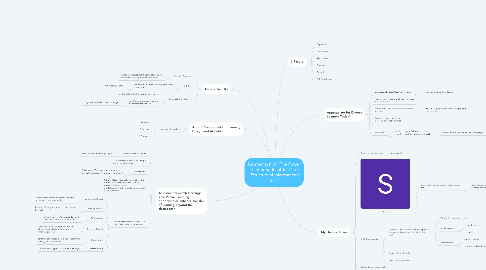
1. A, B, C Components of Learning Design and Activities
1.1. teach whole student
1.1.1. Affective
1.1.2. Behavioral
1.1.3. Cognitive
2. Assessments match learning? Vice Versa? Learning opportunities enhance transfer of learning beyond the classroom?
2.1. Examples for real world
2.1.1. seen in Desired results (stage 1)
2.2. Give students purpose/meaning in assignments/lessons
2.3. Assessments
2.3.1. Performance Task: explained, referred throughout lessons from week 1 to week 4
2.4. Others: Need more defined: what are the formative assessments? what type of quizzes? How will teacher grade/assess/check for understanding each day? each week?
2.5. Rubric: Standards--Exceed, Meet, Approach, Need Improvement
2.5.1. Content and Focus
2.5.1.1. Clear understanding of information and audience, purpose of writing
2.5.2. Writing Process
2.5.2.1. time and effort, pride in work, complete and thorough
2.5.3. Organization
2.5.3.1. Organized: easy to read/understand, transitions, order of information
2.5.4. Style and Format
2.5.4.1. Tone clear, structure and features clear, demonstrate ability of how to write informational text
2.5.5. Conventions
2.5.5.1. sentence structures, tone is clear, grammar, spelling, and punctuation
2.5.6. Presentations
2.5.6.1. format: neat, typed, font, titles, headings
3. Desired Results
3.1. Essential Questions
3.1.1. relates to understanding completely: by the end understanding answers questions
3.2. Big Ideas
3.2.1. embedded in understanding, skills, and knowledge
3.2.1.1. not explicitly stated
3.3. Essential Understanding
3.3.1. real world application, purpose/meaning
3.3.2. what/how/why a critical reader finds/analyzes answers
3.3.2.1. bring back to goals/skills/knowledge
4. 6 Facets:
4.1. Explanation
4.2. Interpretion
4.3. Application
4.4. Perspective
4.5. Empathy
4.6. Self-Knowledge
5. Appropriate for Diverse Learners Today?
5.1. Connect multimedia/past work in units
5.1.1. assess student prior knowledge
5.2. Pacing: days at the end of each week are used as a buffer
5.3. Weekly check-ins: formative assessments, homework
5.3.1. days for higher/lower students (depth and interventions)
5.4. Graphic organizers for new materials/concepts/practice
5.5. Work time
5.5.1. whole group, small groups, partner: activities, think-pair-share, individual
5.5.1.1. Options: how is teacher creating groupings?
5.5.1.1.1. Determination of who is working together?
5.5.1.1.2. Who is giving feedback to peers (comments on blog, editing, workshops, partner work)
6. My Unit vs. Theirs
6.1. Better representation of curriculum design?
6.2. Specifics
6.2.1. more explicit in purpose of performance task
6.2.1.1. relate at each week, stage, students learn why they are learning
6.3. A, B, C constructs
6.3.1. "we don't teach content, we teach people. the content is what we are sharing with them."
6.3.1.1. Dewey "school in the real world
6.3.1.2. meaningfulness
6.3.1.2.1. learning styles
6.3.1.2.2. scaffold
6.3.1.3. transferability
6.3.1.3.1. authentic learning
6.3.1.3.2. use of prior knowledge
6.3.2. Theirs: More integrated
6.3.3. Mine: more separated
6.4. Differentiation opportunities
6.5. Meaningful engagement
6.6. Areas do well/lacking
6.6.1. Mine
6.6.1.1. Grade appropriate essential questions
6.6.1.2. performance task
6.6.1.2.1. Well: all aspects included
6.6.1.2.2. lack: need to use to develop unit: state explicitly
6.6.1.3. learning events: developed/related to EQs
6.6.1.4. WHERETO: expanded and clear

